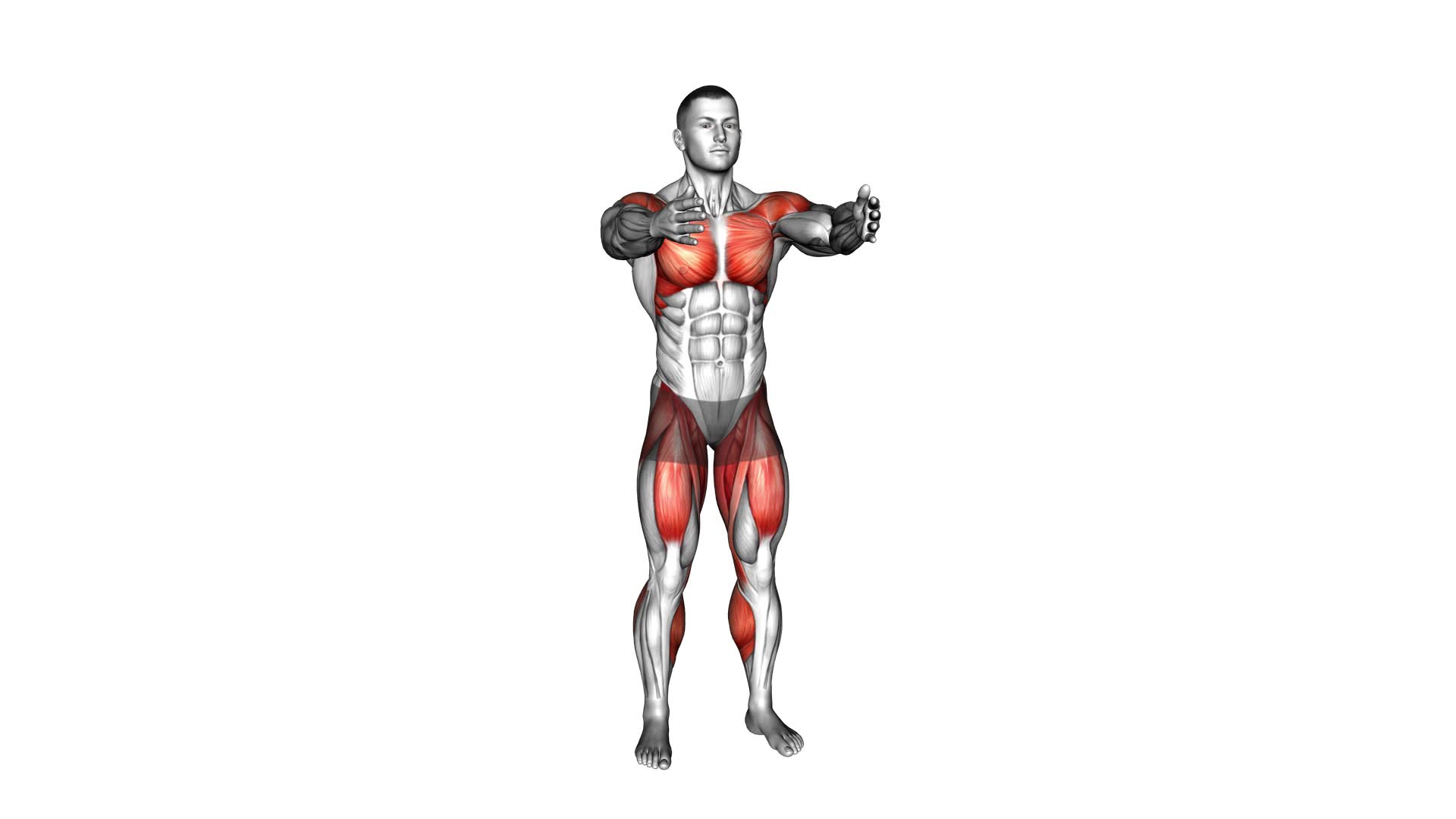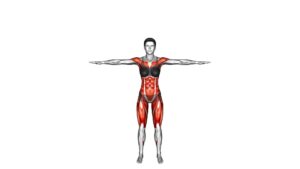Front Leg Lift Under Knee Tap (male) – Video Exercise Guide & Tips

Are you looking for a challenging exercise to target your lower body? Look no further than the front leg lift under knee tap.
Watch This Exercise Video
This exercise is designed to strengthen your legs and improve your balance. In this video exercise guide, we will show you the proper form and technique for performing the front leg lift under knee tap.
Follow along and get ready to feel the burn in your legs!
Key Takeaways
- Front leg lift under knee tap is beneficial for strengthening the legs and improving balance.
- It promotes proper knee alignment and engages the core muscles.
- Practicing proper form and technique is crucial to avoid common mistakes and ensure effectiveness.
- The difficulty of the exercise can be increased by adding ankle weights or performing variations such as increasing the leg lift or using resistance bands.
Benefits of the Front Leg Lift Under Knee Tap
Improve your balance and flexibility with the Front Leg Lift Under Knee Tap. This exercise offers several benefits, including proper knee alignment and engaging core muscles.
Proper knee alignment is crucial for maintaining joint health and preventing injuries. During the Front Leg Lift Under Knee Tap, you're required to lift your leg while keeping your knee in line with your hip and ankle. This helps to strengthen the muscles around your knee and promotes stability in the joint. By practicing this exercise regularly, you can improve your body's overall alignment and reduce the risk of knee-related issues.
In addition to knee alignment, the Front Leg Lift Under Knee Tap also engages your core muscles. As you lift your leg, you have to stabilize your body and prevent any excessive swaying or tilting. This requires the activation of your abdominal and back muscles, which helps to improve your balance and stability. Engaging your core muscles also helps to support your spine and improve your posture.
Incorporating the Front Leg Lift Under Knee Tap into your fitness routine can be beneficial for both your knee health and core strength. Remember to focus on proper knee alignment and engage your core muscles throughout the exercise for maximum benefits.
Proper Form and Technique for the Front Leg Lift Under Knee Tap
To execute the Front Leg Lift Under Knee Tap with proper form and technique, focus on maintaining proper knee alignment and engaging your core muscles. Begin by standing with your feet hip-width apart and your arms extended in front of you. Shift your weight onto your left leg and lift your right leg straight in front of you, keeping it parallel to the floor. As you lift your leg, make sure to keep your knee in line with your hip and avoid any twisting or rotating movements. This will help to engage your hip flexors and maintain stability throughout the exercise.
Next, lower your right leg and bring your right knee towards your left knee, tapping your right knee with your left hand. Be sure to keep your core muscles engaged and your spine straight as you perform this movement. This will help to strengthen your core and improve your balance.
If you find the Front Leg Lift Under Knee Tap too challenging, there are modifications you can make. Instead of lifting your leg straight in front of you, you can start by lifting it slightly to the side. This will decrease the demand on your hip flexors and make the exercise more accessible.
Alternatively, if you're looking for knee tap alternatives, you can try the Standing Knee Crunch or the Standing Knee Raise. These exercises target similar muscle groups and can provide a good alternative to the Front Leg Lift Under Knee Tap.
Common Mistakes to Avoid During the Front Leg Lift Under Knee Tap
When performing the front leg lift under knee tap, it's important to pay attention to proper knee alignment. Make sure your knee is in line with your toes and not collapsing inward or outward. This will help prevent unnecessary strain on the knee joint and ensure proper form.
Additionally, engaging your core muscles throughout the exercise is crucial for stability and control. By keeping your core tight, you'll maintain balance and protect your lower back.
Proper Knee Alignment
For proper knee alignment during the Front Leg Lift Under Knee Tap, make sure to keep your knee directly above and in line with your ankle. Proper knee alignment is crucial to prevent injuries and maximize the benefits of this exercise.
When your knee is directly above your ankle, it helps distribute the weight evenly and reduces unnecessary stress on the knee joint. This alignment also ensures that the muscles surrounding the knee, such as the quadriceps and hamstrings, are engaged properly, leading to improved strength and stability.
To improve knee alignment, you can incorporate knee alignment exercises into your workout routine. These exercises, such as squats and lunges, focus on strengthening the muscles around the knee, promoting proper alignment and reducing the risk of injury.
Remember to pay attention to your knee position throughout the Front Leg Lift Under Knee Tap to maintain proper alignment and reap the full benefits of this exercise.
Engaging Core Muscles
Engage your core muscles to maximize the effectiveness of the Front Leg Lift Under Knee Tap exercise. Core stability plays a crucial role in this exercise, as it helps maintain balance and control throughout the movement. By activating your core, you create a solid foundation for your body, allowing you to perform the exercise with proper form and reduced risk of injury.
To engage your core, focus on contracting your abdominal muscles. Imagine pulling your belly button towards your spine, as if you were trying to create a flat stomach. This will activate your deep core muscles, providing the necessary stability for the exercise.
Maintaining abdominal strength is essential for executing the Front Leg Lift Under Knee Tap correctly. Weak abdominal muscles can lead to compensations and poor form, decreasing the effectiveness of the exercise. Regular core strengthening exercises, such as planks and crunches, can help improve your abdominal strength, enhancing your performance in this exercise.
Tips to Increase the Difficulty of the Front Leg Lift Under Knee Tap
To make the Front Leg Lift Under Knee Tap more challenging, try adding additional weight to your ankles. By increasing the intensity of this exercise, you can further strengthen and tone your leg muscles. Adding ankle weights will create resistance, forcing your muscles to work harder and making the exercise more challenging.
To begin, you'll need a pair of ankle weights that are suitable for your fitness level. Start by strapping the weights securely around your ankles. It's important to choose a weight that's challenging but still allows you to maintain proper form throughout the exercise.
Once you have the ankle weights on, perform the Front Leg Lift Under Knee Tap as you normally would. Lift your leg straight in front of you, keeping it as straight as possible, and tap your knee with your opposite hand. Lower your leg back down and repeat on the other side.
The added weight will require your muscles to exert more effort, increasing the intensity of the exercise. This advanced modification will provide a greater challenge and help you progress in your fitness journey. Remember to listen to your body and gradually increase the weight as you become stronger and more comfortable with the exercise.
Modifications and Variations for the Front Leg Lift Under Knee Tap
To modify the front leg lift under knee tap exercise, you can try the alternative knee tap variation. Instead of tapping your knee, bring your elbow down to meet your opposite knee, engaging your core even more.
Another variation is to increase the leg lift by extending your leg higher, challenging your hip flexors and glutes.
Alternative Knee Tap
You can easily modify and vary the Front Leg Lift Under Knee Tap exercise by incorporating alternative knee tap movements.
Instead of tapping your knee with the opposite hand, you can try tapping your knee with the same side hand. This variation puts more focus on your core and obliques, as you have to stabilize your body while performing the movement.
Another alternative knee tap exercise is the knee cross tap. Instead of tapping your knee with your hand, you can tap across your body, touching your opposite knee with your hand. This variation adds a rotational element to the exercise, engaging your obliques even more.
By incorporating these alternative knee tap exercises, you can keep your workouts fresh and challenge different muscle groups.
Now, let's move on to the next section and explore how to increase the leg lift in the Front Leg Lift Under Knee Tap exercise.
Increased Leg Lift
To increase the leg lift in the Front Leg Lift Under Knee Tap exercise, try incorporating modifications and variations. These adjustments won't only challenge your muscles in new ways but also improve your overall flexibility and balance.
Here are three modifications you can try:
- Elevated leg lift: Instead of lifting your leg straight in front of you, try lifting it higher by extending it towards the ceiling. This will require increased flexibility in your hip flexors and hamstrings.
- Weighted leg lift: Add ankle weights or hold a dumbbell between your feet to increase the resistance and further engage your leg muscles. This modification will enhance both strength and balance.
- Single-leg balance: Perform the exercise on one leg at a time, lifting the opposite leg off the ground and tapping the knee. This variation will challenge your balance and stability, while also targeting the muscles of the standing leg.
Incorporating these modifications won't only intensify your workout but also provide additional benefits to your flexibility and balance training.
Adding Resistance Bands
Incorporating resistance bands can further enhance the Front Leg Lift Under Knee Tap exercise by adding additional challenge and strengthening your leg muscles.
Resistance bands are a great tool for adding resistance to your workout routine and can be easily incorporated into the Front Leg Lift Under Knee Tap exercise.
To perform this advanced modification, secure the resistance band around a stable object and loop it around your ankle.
As you lift your leg, the resistance from the band will engage your muscles even more, increasing the intensity of the exercise.
This won't only target your quadriceps and glutes, but also challenge your stability and balance.
Safety Precautions and Considerations for the Front Leg Lift Under Knee Tap
Before attempting the front leg lift under knee tap, be mindful of safety precautions and considerations. This exercise can be challenging and puts stress on your knees, so it's important to take the necessary precautions to prevent injury.
Here are three important safety tips to keep in mind:
- Proper Warm-up: Before starting any exercise, it's crucial to warm up your body. Perform dynamic stretches and light cardiovascular exercises to increase blood flow and prepare your muscles for the workout. This will help reduce the risk of muscle strains or joint injuries.
- Maintain Proper Knee Alignment: During the front leg lift under knee tap, it's essential to maintain proper knee alignment. Make sure your knee stays in line with your toes and doesn't cave in or outwards. This will help prevent unnecessary stress on the knee joint and reduce the risk of injury.
- Start with a Suitable Weight: If you're using weights or resistance bands for this exercise, start with a weight that challenges you but still allows you to maintain proper form. Using weights that are too heavy can compromise your form and increase the risk of injury. Gradually increase the weight as your strength and control improve.
Frequently Asked Questions
How Many Calories Does the Front Leg Lift Under Knee Tap Exercise Burn?
The front leg lift under knee tap exercise is a great way to target your lower body and engage your core muscles. By incorporating this exercise into your workout routine, you can burn a significant amount of calories.
It's an effective variation of the leg lift exercise that adds an extra challenge by tapping your knee with the opposite hand. This exercise not only burns calories but also helps improve balance, coordination, and overall strength.
Can the Front Leg Lift Under Knee Tap Help in Reducing Belly Fat?
Front Leg Lift Under Knee Tap is an exercise that targets multiple muscles in your lower body, including your abs. It can be effective in reducing belly fat when combined with a healthy diet and regular cardio exercise.
The exercise engages your core muscles, helping to strengthen and tone them. By incorporating this exercise into your fitness routine, you can increase your overall calorie burn and promote fat loss.
Consistency and proper form are key for optimal results.
Can the Front Leg Lift Under Knee Tap Be Done by Beginners?
Are you a beginner wondering if the front leg lift under knee tap exercise is safe for you?
Are there any modifications available?
Well, let's address these concerns.
The front leg lift under knee tap can definitely be performed by beginners, but it's important to start slow and focus on proper form.
You can modify the exercise by reducing the range of motion or using a support for balance.
Remember to listen to your body and consult a professional if needed.
What Muscles Are Targeted During the Front Leg Lift Under Knee Tap?
During the front leg lift under knee tap exercise, several muscles are targeted.
These include the quadriceps, hamstrings, glutes, and core muscles.
The quadriceps are responsible for extending the knee, while the hamstrings assist in flexing the hip.
The glutes help stabilize the pelvis and maintain balance.
Additionally, the core muscles are engaged to maintain proper posture and stability throughout the movement.
Incorporating this exercise into your routine can benefit your leg and core strength, balance, and stability.
Is It Necessary to Warm up Before Performing the Front Leg Lift Under Knee Tap?
Yes, it's necessary to warm up before performing the front leg lift under knee tap.
Warming up helps prepare your body for exercise by increasing blood flow, loosening up your muscles, and improving your range of motion.
It also reduces the risk of injury during the exercise.
If the front leg lift under knee tap is too challenging or not suitable for you, there are alternative exercises you can try, such as standing leg lifts or seated knee taps.
Conclusion
In conclusion, the front leg lift under knee tap is an effective exercise for strengthening the lower body and improving balance. By following proper form and technique, individuals can maximize the benefits of this exercise while avoiding common mistakes.
To increase the difficulty, incorporating variations and modifications can challenge different muscle groups. It's important to prioritize safety and consider any limitations or injuries before attempting this exercise.
With consistent practice, the front leg lift under knee tap can help individuals achieve their fitness goals.

Author
Years ago, the spark of my life’s passion ignited in my mind the moment I stepped into the local gym for the first time. The inaugural bead of perspiration, the initial endeavor, the very first surge of endorphins, and a sense of pride that washed over me post-workout marked the beginning of my deep-seated interest in strength sports, fitness, and sports nutrition. This very curiosity blossomed rapidly into a profound fascination, propelling me to earn a Master’s degree in Physical Education from the Academy of Physical Education in Krakow, followed by a Sports Manager diploma from the Jagiellonian University. My journey of growth led me to gain more specialized qualifications, such as being a certified personal trainer with a focus on sports dietetics, a lifeguard, and an instructor for wellness and corrective gymnastics. Theoretical knowledge paired seamlessly with practical experience, reinforcing my belief that the transformation of individuals under my guidance was also a reflection of my personal growth. This belief holds true even today. Each day, I strive to push the boundaries and explore new realms. These realms gently elevate me to greater heights. The unique combination of passion for my field and the continuous quest for growth fuels my drive to break new ground.



